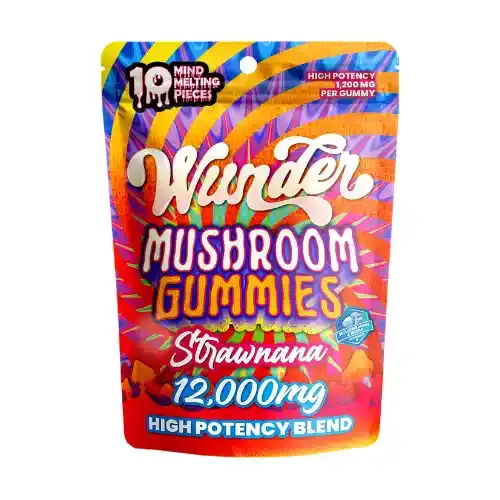
Growing Magic Mushrooms 101
Magic mushrooms have captivated the imagination of people for centuries, offering a unique blend of mysticism and biological wonder. Whether you're intrigued by their psychedelic properties or simply fascinated by their growth process, cultivating magic mushrooms can be a deeply rewarding endeavor. This blog aims to guide you through the intricacies of growing your own magic mushrooms, from understanding their basic biology to mastering the cultivation techniques.
Before we dive in, it's essential to address the legal considerations. The cultivation, possession, and use of magic mushrooms are subject to strict laws in many regions. Make sure to research and comply with your local regulations to avoid legal repercussions.
Growing magic mushrooms requires careful preparation and attention to detail. We'll cover everything you need to know, including the necessary supplies, the best strains for beginners, and a step-by-step guide to the growing process. Additionally, we'll explore post-harvest techniques and troubleshooting common issues to ensure your cultivation journey is successful.
Whether you're a curious novice or an aspiring mycologist, this comprehensive guide will provide you with the knowledge and confidence to grow magic mushrooms safely and effectively. Let's embark on this fascinating journey into the world of mycology together.
Understanding the Magic of Mushrooms

Magic mushrooms, scientifically known as psilocybin mushrooms, are a group of fungi that contain the psychoactive compounds psilocybin and psilocin. These mushrooms have been used for thousands of years in various cultural and spiritual practices, revered for their mind-altering effects and their potential to facilitate profound mystical experiences.
There are many species of magic mushrooms, with Psilocybe cubensis being one of the most well-known and commonly cultivated. These fungi thrive in tropical and subtropical environments, growing naturally in regions across North and South America, Southeast Asia, and Europe.
The primary psychoactive ingredient, psilocybin, is a naturally occurring compound that, when ingested, is converted into psilocin in the body. Psilocin interacts with serotonin receptors in the brain, leading to altered perceptions, mood changes, and a sense of expanded consciousness. The effects can vary widely based on the dosage, individual physiology, and the environment in which they are consumed.
Understanding the biology and chemistry of magic mushrooms is crucial for successful cultivation. These mushrooms grow through a symbiotic relationship with their environment, often requiring specific substrates like brown rice flour or vermiculite to flourish. The growth cycle involves several stages, including spore germination, mycelium colonization, and fruiting.
Magic mushrooms have garnered significant attention in recent years for their potential therapeutic benefits, particularly in treating conditions such as depression, anxiety, and PTSD. As research continues to uncover the profound effects of psilocybin, the interest in growing these remarkable fungi has surged. By delving into their history, biology, and effects, we can better appreciate the intricate world of magic mushrooms and the transformative experiences they offer.
Considerations Before Growing

Before embarking on the journey of growing magic mushrooms, thorough preparation is essential to ensure a successful and safe cultivation process. This preparation phase involves understanding legal considerations, gathering necessary supplies, and selecting the right mushroom strain.
Legal Considerations
The legality of growing magic mushrooms varies significantly across different regions. In many places, psilocybin mushrooms are classified as controlled substances, making their cultivation, possession, and use illegal. It's crucial to research and understand the laws in your area to avoid legal complications. Some regions allow the cultivation of certain types of mushrooms for research purposes or personal use, but these exceptions are rare. Always ensure you are compliant with local regulations before proceeding.
Gathering Supplies
Successful mushroom cultivation requires a specific set of tools and materials. Essential supplies include:
- Spore Syringes or Spore Prints: These are the starting points for growing mushrooms.
- Substrate Materials: Common substrates include brown rice flour, vermiculite, and coco coir.
- Jars or Containers: Typically, wide-mouth jars are used for the substrate.
- Pressure Cooker or Sterilizer: Used to sterilize the substrate and prevent contamination.
- Gloves and Alcohol Wipes: To maintain a sterile environment during inoculation.
- Fruiting Chamber: A controlled environment where mushrooms will grow and mature.
These supplies can often be purchased from specialty gardening stores or online retailers that cater to mycology enthusiasts.
Choosing a Strain
Selecting the right mushroom strain is crucial for beginners. Some strains are more resilient and easier to grow than others. Psilocybe cubensis, particularly the B+ and Golden Teacher varieties, are popular choices for novice growers due to their forgiving nature and robust growth. These strains typically require similar conditions and provide a reliable yield, making them ideal for those new to mushroom cultivation.
Proper preparation sets the foundation for a successful growing experience. By ensuring legal compliance, gathering the right supplies, and choosing an appropriate strain, you’ll be well-equipped to embark on your journey into the world of magic mushroom cultivation.
Cultivating Magic: The Growing Process

Growing magic mushrooms is a meticulous process that, when done correctly, yields fascinating and rewarding results. This step-by-step guide will walk you through the essential stages of cultivation, from preparing the substrate to harvesting your first flush of mushrooms.
Step 1: Preparing the Substrate
The substrate serves as the nutritional foundation for your mushrooms. A popular choice is the PF Tek method, which utilizes a mix of brown rice flour, vermiculite, and water. Begin by combining these ingredients in a large mixing bowl. Once mixed, fill your wide-mouth jars with the substrate mixture, leaving some space at the top. Cover the jars with a layer of dry vermiculite to act as a contamination barrier.
Sterilization is critical to prevent unwanted bacteria and mold. Place the jars in a pressure cooker and sterilize at 15 PSI for 45-60 minutes. Allow the jars to cool to room temperature before proceeding to the next step.
Step 2: Inoculation
Inoculation is the process of introducing mushroom spores into the sterilized substrate. Using a sterile spore syringe, inject the spores into the substrate through the holes in the jar lids. It’s crucial to work in a clean environment to minimize the risk of contamination. Wipe the syringe needle with alcohol between injections and use sterile gloves.
Step 3: Incubation
After inoculation, store the jars in a warm, dark place to promote mycelium growth. The ideal temperature for incubation is between 75-81°F (24-27°C). Over the next 2-4 weeks, the spores will germinate and colonize the substrate, forming a network of white mycelium. Monitor the jars regularly, looking out for any signs of contamination such as unusual colors or smells.
Step 4: Fruiting
Once the substrate is fully colonized with mycelium, it’s time to initiate fruiting. Carefully remove the colonized substrate from the jars and place it in a fruiting chamber—a container designed to maintain high humidity and provide fresh air exchange. A simple fruiting chamber can be made from a clear plastic bin with holes drilled for ventilation.
Maintain the environment within the chamber at 85-95% humidity and a temperature of 70-75°F (21-24°C). Mist the chamber regularly and ensure adequate air circulation. Provide indirect light for 12 hours a day to mimic natural daylight cycles.
Step 5: Harvesting
Within a week or two, you’ll notice pinheads (tiny mushroom primordia) forming on the substrate. These will quickly develop into mature mushrooms. Harvesting should be done when the veil under the mushroom cap begins to tear away from the stem, indicating peak potency.
To harvest, gently twist and pull the mushrooms from the substrate, taking care not to disturb the mycelium. Harvested mushrooms can be consumed fresh or dried for later use.
By following these steps with attention to detail and cleanliness, you can successfully cultivate your own magic mushrooms. This rewarding process not only provides a fascinating glimpse into the world of fungi but also opens the door to exploring the profound experiences these mushrooms can offer.
Beyond the Harvest: Post-Harvest Considerations

Harvesting your magic mushrooms is just the beginning of the journey. Proper post-harvest care ensures that you can enjoy the fruits of your labor for months to come.
Drying Your Mushrooms
To preserve their potency and prevent spoilage, drying your mushrooms is crucial. Start by placing your freshly harvested mushrooms on a drying rack in a well-ventilated area. For optimal results, use a food dehydrator set to a low temperature (95-105°F or 35-40°C). Drying can take several hours to a couple of days, depending on the size and moisture content of the mushrooms. The mushrooms are ready when they are crisp and snap easily.
Storage Solutions
Once dried, store your mushrooms in an airtight container to protect them from moisture and air. Adding a desiccant pack can help keep them dry. For long-term storage, vacuum-sealed bags kept in a cool, dark place are ideal. Properly stored, dried mushrooms can retain their potency for over a year.
Microdosing and Usage
Understanding dosage is essential, especially if you plan to microdose. Start with a small amount (0.1-0.3 grams) to gauge the effects and adjust accordingly. For a full psychedelic experience, a typical dose ranges from 1-3 grams. Always proceed with caution and in a safe, comfortable environment.
By following these post-harvest steps, you can ensure that your magic mushrooms remain potent and safe for future use, allowing you to fully explore their mystical and therapeutic potential.
A Journey into Mycology: Your Next Steps
Embarking on the adventure of growing magic mushrooms is a deeply rewarding and educational experience. From understanding their mystical properties to mastering the cultivation process, you've now gained the knowledge to start your own mycological journey. Remember, the key to success lies in preparation, attention to detail, and a commitment to cleanliness and patience.
As you explore this fascinating world, we encourage you to share your experiences and continue learning. For more tips, advanced techniques, and support from a community of enthusiasts, visit our website. Don't hesitate to fill out our contact form for personalized advice and updates. Let’s continue this journey together and uncover the magic that awaits!










